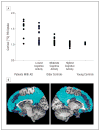Association of lifetime cognitive engagement and low β-amyloid deposition
- PMID: 22271235
- PMCID: PMC3747737
- DOI: 10.1001/archneurol.2011.2748
Association of lifetime cognitive engagement and low β-amyloid deposition
Abstract
Objective: To assess the association between lifestyle practices (cognitive and physical activity) and β-amyloid deposition, measured with positron emission tomography using carbon 11-labeled Pittsburgh Compound B ([(11)C]PiB), in healthy older individuals.
Design: Cross-sectional clinical study.
Setting: Berkeley, California.
Participants: Volunteer sample of 65 healthy older individuals (mean age, 76.1 years), 10 patients with Alzheimer disease (AD) (mean age, 74.8 years), and 11 young controls (mean age, 24.5 years) were studied from October 31, 2005, to February 22, 2011.
Main outcome measures: Cortical [(11)C]PiB average (frontal, parietal, lateral temporal, and cingulate regions) and retrospective, self-report scales assessing participation in cognitive activities (eg, reading, writing, and playing games) and physical exercise.
Results: Greater participation in cognitively stimulating activities across the lifespan, but particularly in early and middle life, was associated with reduced [(11)C]PiB uptake (P<.001, accounting for age, sex, and years of education). Older participants in the highest cognitive activity tertile had [(11)C]PiB uptake comparable to young controls, whereas those in the lowest cognitive activity tertile had [(11)C]PiB uptake comparable to patients with AD. Although greater cognitive activity was associated with greater physical exercise, exercise was not associated with [(11)C]PiB uptake.
Conclusions: Individuals with greater early- and middle-life cognitive activity had lower [(11)C]PiB uptake. The tendency to participate in cognitively stimulating activities is likely related to engagement in a variety of lifestyle practices that have been implicated in other studies showing reduced risk of AD-related pathology. We report a direct association between cognitive activity and [(11)C]PiB uptake, suggesting that lifestyle factors found in individuals with high cognitive engagement may prevent or slow deposition of β-amyloid, perhaps influencing the onset and progression of AD.
Figures


Comment in
-
Physical activity and AD-related pathology.Arch Neurol. 2012 Jul;69(7):940-1; author reply 941. doi: 10.1001/archneurol.2012.507. Arch Neurol. 2012. PMID: 22777267 No abstract available.
Similar articles
-
Subjective cognition and amyloid deposition imaging: a Pittsburgh Compound B positron emission tomography study in normal elderly individuals.Arch Neurol. 2012 Feb;69(2):223-9. doi: 10.1001/archneurol.2011.666. Arch Neurol. 2012. PMID: 22332189 Free PMC article.
-
Alzheimer's disease neurodegenerative biomarkers are associated with decreased cognitive function but not β-amyloid in cognitively normal older individuals.J Neurosci. 2013 Mar 27;33(13):5553-63. doi: 10.1523/JNEUROSCI.4409-12.2013. J Neurosci. 2013. PMID: 23536070 Free PMC article.
-
Amyloid PET imaging in patients with mild cognitive impairment: a 2-year follow-up study.Neurology. 2011 Mar 22;76(12):1085-90. doi: 10.1212/WNL.0b013e318212015e. Epub 2011 Feb 16. Neurology. 2011. PMID: 21325653
-
PET imaging of brain amyloid in dementia: a review.Int J Geriatr Psychiatry. 2011 Oct;26(10):991-9. doi: 10.1002/gps.2640. Epub 2010 Dec 28. Int J Geriatr Psychiatry. 2011. PMID: 21905095 Review.
-
Integrating Lifestyle Factor Science into Neuropsychological Practice: A National Academy of Neuropsychology Education Paper.Arch Clin Neuropsychol. 2024 Feb 19;39(2):121-139. doi: 10.1093/arclin/acad078. Arch Clin Neuropsychol. 2024. PMID: 37873931 Review.
Cited by
-
Nonpharmacologic treatment and prevention strategies for dementia.Continuum (Minneap Minn). 2013 Apr;19(2 Dementia):372-81. doi: 10.1212/01.CON.0000429178.14354.67. Continuum (Minneap Minn). 2013. PMID: 23558483 Free PMC article. Review.
-
Lifestyle Affects Amyloid Burden and Cognition Differently in Men and Women.Ann Neurol. 2022 Sep;92(3):451-463. doi: 10.1002/ana.26417. Epub 2022 Jun 14. Ann Neurol. 2022. PMID: 35598071 Free PMC article.
-
Association of Modifiable Lifestyle Factors With Cortical Amyloid Burden and Cerebral Glucose Metabolism in Older Adults With Mild Cognitive Impairment.JAMA Netw Open. 2020 Jun 1;3(6):e205719. doi: 10.1001/jamanetworkopen.2020.5719. JAMA Netw Open. 2020. PMID: 32515796 Free PMC article.
-
The Effect of a Multicomponent Dual-Task Exercise on Cortical Thickness in Older Adults with Cognitive Decline: A Randomized Controlled Trial.J Clin Med. 2020 May 2;9(5):1312. doi: 10.3390/jcm9051312. J Clin Med. 2020. PMID: 32370159 Free PMC article.
-
The relationship between leisure time physical activity patterns, Alzheimer's disease markers and cognition.Brain Commun. 2025 Jan 31;7(1):fcae431. doi: 10.1093/braincomms/fcae431. eCollection 2025. Brain Commun. 2025. PMID: 39898325 Free PMC article.
References
-
- Klunk WE, Engler H, Nordberg A, et al. Imaging brain amyloid in Alzheimer’s disease with Pittsburgh Compound-B. Ann Neurol. 2004;55(3):306–319. - PubMed
-
- Pike KE, Savage G, Villemagne VL, et al. β-Amyloid imaging and memory in non-demented individuals: evidence for preclinical Alzheimer’s disease. Brain. 2007;130(pt 11):2837–2844. - PubMed
-
- Bennett DA, Schneider JA, Arvanitakis Z, et al. Neuropathology of older persons without cognitive impairment from two community-based studies. Neurology. 2006;66(12):1837–1844. - PubMed
Publication types
MeSH terms
Substances
Grants and funding
LinkOut - more resources
Full Text Sources
Medical

